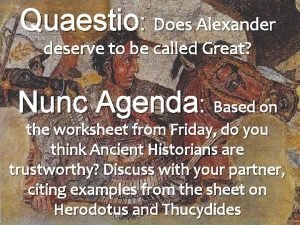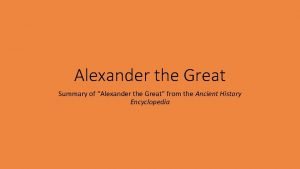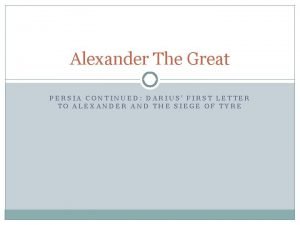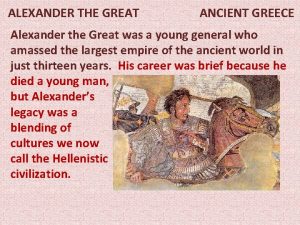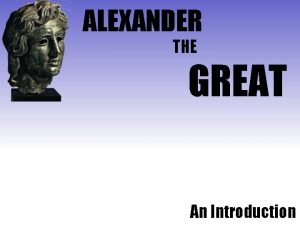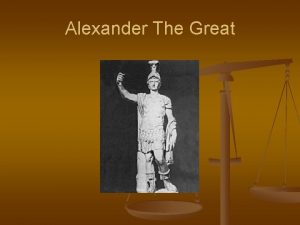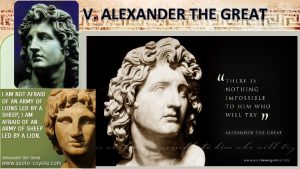Alexander the Great Summary of Alexander the Great






- Slides: 6

Alexander the Great Summary of “Alexander the Great” from the Ancient History Encyclopedia

Alexander’s Youth • Alexander was taught to ride and fight, to read and write, and to play the lyre. • His father, Philip II (King of Macedonia), wanted him to have a classical education. • Alexander had a number of tutors, including Aristotle in his adolescence. • He tamed a wild horse named Bucephalus, who later accompanied him in battle. • He loved Homer’s epic poems and modelled himself after Herakles and Achilles (both of which, like Alexander, are said to be sons of Zeus or demigods).

Charonea and the Early Campaigns • At the age of 18, Alexander first distinguished himself militarily at the Battle of Charonea as Philip II expanded Macedonian power into the rest of Greece. • After his father’s death, he brought over 30, 000 troops into the Persian Empire. • He was curious about the areas he conquered and asked scientists to catalogue each area’s geography and natural environment (more likely inspired by Aristotle). • He conquered Egypt and founded the city of Alexandria, which he helped design. • He did not impose his own ideas and religion as long as those who were conquered allowed free supply lines to his troops. • He ruthlessly suppressed revolts and resistance, however. For example, after conquering the island of Tyre, its inhabitants were slaughtered or sold into slavery.

The Persian Campaigns • He fought against the Persian armies of Darius III even though the Persian army was much larger. • Alexander expanded east into Persian Empire • He ordered the burning of the palace of the Persian capital, Persepolis, to avenge Xerxes’ burning of the Acropolis. • He defeated the Persian army and proclaimed himself the king of Asia and adopted many Persian customs for which he was criticized by his own troops (e. g. , proskynesis = kneeling and kissing the hand of the king). • He founded many cities bearing his name. • He executed those who opposed or conspired against him, even if they were close advisers. • He drank often and made military decisions while drunk, often leading to brutal acts such as the burning and killing of places and people.

India and Mutiny • Alexander attempted to conquer India. Some tribes relented while others openly resisted. • He promoted fierce rulers who fought bravely against him. • Bucephalus died in one of the battles, and Alexander named a city after the horse. • Some rulers appointed by Alexander abused their power and were thus executed. • He attempted to integrate the cultures of Persia and India into his own (e. g. , gave Persians important roles and titles, married Persian women). • Alexander stopped at the River Ganges when his troops who were tired of fighting mutinied. • He slaughtered inhabitants of a town as sacrifice when his second in command died.

Alexander’s Death • Alexander died in Babylon at the age of 32 as a result of a high fever. • Some theories about his death include poisoning and disease. • He appointed “the strongest” as his successor, so his kingdom was split four parts (each ruled by one of his generals). • Successors were known as Diadochi. • One of his successors, Cassander, ordered the execution of Alexander’s wife, son and mother. • His successors generally held their territory until the expansion of the Roman Empire. • The spread of Greek culture and ideas during the rule of Diadochi is referred to as the Hellenistic Period.

